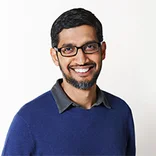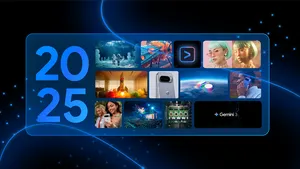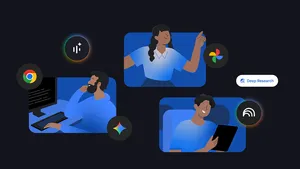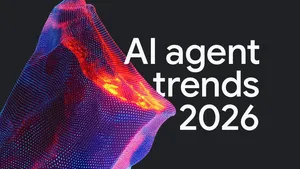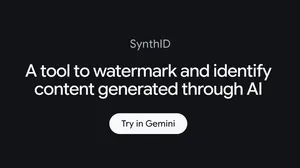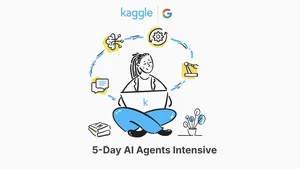The AI Action Summit: A golden age of innovation
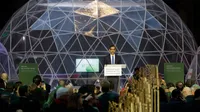
Editor’s note: Today, Google CEO Sundar Pichai spoke in Paris, France at the AI Action Summit. What follows is a transcript of the remarks, as prepared for delivery.
Distinguished leaders, everyone: I’m excited to be here with you all today.
President Macron, thank you for the invitation and for gathering such an esteemed group here.
AI is a once in a lifetime technology. And conversations like these, ones focused on collaboration and concrete action, will move this work forward.
As today’s sessions come to a close, I want to share some examples of why I’m so optimistic about AI and its applications — and the opportunity we have to benefit everyone, everywhere.
Improving lives through technology is personal for me.
I grew up in Chennai, India. Each new technology took a while to arrive at our doorstep. That included the rotary phone. We were on a five-year wait list. And when it finally came, the phone changed our lives.
Before I would need to take a four hour round trip to get blood test results for my mother. And sometimes I would go all the way to the hospital and they would say, "No, it's not ready. Come back tomorrow." Now, we only had to pick up the phone.
I saw the positive impact technology could have to make things better. It set me on a course that would bring me to the U.S., and eventually to a growing start-up called Google.
I couldn’t have imagined then that one day I would toast three Google colleagues their Nobel Prizes, or take my parents for a ride in a driverless car, all within a couple of weeks. And all because of another technology: AI.
We’re still in the early days, yet I already believe AI will be the most profound shift of our lifetimes.
Bigger than the shift to personal computing, or to mobile. And it will do more to democratize access to information than the internet.
In 18 months, the cost to process one token — or the building blocks used for processing information — has come down 97% for developers. So what used to cost four dollars per million tokens now costs just 13 cents, and I expect this trend to continue.
The result: intelligence is more available and accessible than ever before.
So, this moment has the characteristics of a platform shift. But what makes it so profound? A couple of things:
As AI interactions come to feel more intuitive and human — they put us at the center of the experience. Technology begins to feel like a natural extension, augmenting human capability, bridging gaps in expertise and experience, and breaking down barriers like language and accessibility.
As a truly general purpose technology, AI is applicable across many different human endeavors and all parts of the economy — every company, every sector will use this technology in their own ways, including the public sector.
As it continues to improve, it will spur innovation, opportunity and growth in economies around the world, and drive an explosion in knowledge, learning, creativity, and productivity that will shape the future in exciting ways.
The opportunity with AI is as big as it gets. And it will be up to the people in this room to make sure that as many people as possible benefit.
Why Google invests in AI
That opportunity to improve lives and transform things is why Google has been investing in AI for more than a decade. Because we saw it as the most important way we could advance our mission: to organize the world’s information and make it universally accessible and useful.
Looking back at the defining AI breakthroughs over the last decade, our researchers have been behind a significant number of them. From key language understanding techniques… to an AI that defeated the world’s top Go players… to the Transformer architecture, which underlies today's generative AI revolution, and powers the most advanced AI models.
We continue to push the frontier. Our team’s generative AI papers have been cited 3x more than any other company or educational institution in the world.
Part of advancing the field has meant building the foundational infrastructure. That includes our network, which spans more than 2 million miles of terrestrial and subsea fiber cables. We also have custom chips for AI, called Tensor Processing Units, now in their sixth generation. Over the past two generations alone, we’ve improved their carbon efficiency by 3x.
This infrastructure enables frontier models like Gemini, with breakthroughs in processing multimodal information across text, image, video, audio and code — as well as long context and agentic capabilities.
And our infrastructure enables us to make these cutting edge technologies available to developers, entrepreneurs, businesses and more.
Finally, we are building applications that make AI truly helpful to people everywhere. We now have seven products that reach more than 2 billion users — like Maps, Search and Android. All of them are powered by our AI innovations, and our most recent Gemini models.
All of this, together makes up our unique full stack approach to innovation, enabling entirely new experiences.
How AI is enabling new experiences
Some experiences I am very excited about include deep research and thinking capabilities. They make it possible to help people conduct in-depth research on a specific topic. It’s like having a personal research assistant that searches the web, analyzes information and summarizes key findings.
I know many of you are starting to think about your summer plans.
You could ask a deep research agent, “Where in Europe should I vacation for two weeks in August?” Five minutes later, you have a full analysis considering factors like affordability, weather, visa requirements, and more — all with sources cited. And it’s getting faster all the time.
Or maybe instead of searching the internet, you want a model to draw only from the specific documents you give it. That’s what makes NotebookLM so magical. You could imagine transforming a pile of dense documents into engaging podcasts. Over just three months, people generated more than three hundred and fifty years worth of these Audio Overviews. Businesses are using it to create a centralized knowledge repository that acts like an internal expert on policies, procedures, customers and more.
As models become increasingly multimodal, they are getting better at understanding the world around you. Just point your phone camera at something near you, and ask Project Astra about it.
What’s really exciting is how Project Astra brings us closer to our vision for a universal AI assistant that is seamlessly integrated into our lives across different devices and contexts. We’re going to bring capabilities like this to our products soon.
How AI is benefiting science and discovery
These are some examples of how people and businesses are using AI today.
But some of the most exciting examples are happening across science and discovery.
A powerful example is AlphaFold, a major breakthrough in predicting protein’s complex structures. That Nobel Prize toast I mentioned was a direct result of this work done by Demis and John at Google DeepMind. Demis — or should I say Sir Demis — is here today: let’s give him a round of applause.
We opened up AlphaFold in 2021 free of charge to the scientific community. Today more than 2.5 million researchers from over one hundred and ninety countries are using it to develop new malaria vaccines, cancer treatments and even plastic-eating enzymes. We estimate AlphaFold has helped to save hundreds of thousands of research years.
One company building on AlphaFold is Isomorphic Labs, part of Alphabet, Google’s parent company. They’re using machine learning in the drug design process to improve the success rates of therapies, while reducing overall time and cost. And we have partners all over the world using our Cloud technologies for similar work — like Servier, here in France.
Quantum computing will also help scientists discover new medicines… as well as design more efficient batteries for electric cars, and accelerate progress in fusion and new energy alternatives.
It’s the next big paradigm shift in computing, following AI. And we’re making good progress.
Our latest breakthrough was in December. Our state of the art Willow quantum chip solved a computation in under five minutes that would take a classical computer ten septillion years — that’s a one, followed by twenty-five zeros, longer than the universe has existed, several times over.
And it did so while reducing errors even as the number of quantum chips increased. AI helped with that, by the way. And we’ll continue making progress on our journey to a fully error corrected quantum computer.
Now, let me turn to an example that is very much reality: fully autonomous, self-driving cars.
After years of scaling the technology, recent progress has been absolutely breathtaking.
In 2024, Waymo — operating in four cities — made over four million passenger trips.
One of those trips recently brought me and my parents to a park near Golden Gate Bridge in San Francisco.
I had obviously taken Waymos before, but watching my father, who is in his 80s, I saw the progress in a whole new light.
How AI is benefiting society
There are many other instances of how AI is already benefiting society. One example is expanding information access through languages.
When Google Translate first started, the models relied on languages being widely represented on the web. But for most of the world’s languages, especially in places like Africa, that wasn’t the case.
Using AI techniques, we added over 110 new languages to Google Translate last year, spoken by half a billion people around the world. That brings our total to 249 languages, including 60 African languages. More to come.
Another huge opportunity space is health.
Right here in Paris, we're excited to partner with Institut Curie to combine their world-class research with our cutting-edge AI. Our goal is to improve outcomes for women with a number of rare and deadly cancers, including identifying predictive biomarkers for certain uterine cancers, or better predicting how breast cancer patients will respond to specific therapies. We’re honored to work with Institut Curie on this.
In India and Thailand, we’re partnering with local organizations to deliver six million AI screenings for diabetic retinopathy, a preventable cause of blindness. And we’ll do this at no cost to patients.
Beyond health, AI is improving how communities respond to natural disasters.
Our AI-powered FloodHub forecasts now cover more than 100 countries, and more than 700 million people, giving local communities a seven-day lead time — even in areas where data is scarce.
We’re also using AI to map the boundaries of large wildfires and get people accurate information in 27 countries around the world. Over the past year, it reached 30 million people and helped people get to safety during the LA wildfires last month.
Our new FireSat technology will give us even better tools. Using advanced sensors and high resolution, it can detect a fire as small as five-by-five meters. It’s going to be a game-changer for firefighters.
In all these examples, I hope you can see the massive potential for AI to benefit people… boost economies… advance science… and address humanity’s greatest challenges.
But these beneficial outcomes are not automatic or guaranteed.
It will take all of us working together on multiple fronts to make it possible.
What it will take to unlock AI’s potential
Let me be really prescriptive about how.
First, we have to enable an ecosystem of innovators — and adopters.
I spoke of that growing innovation ecosystem here in France earlier — how do we create more of these pockets, in more places?
And as Mario Draghi showed in his recent report, Europe’s productivity is dependent on using these emerging technologies; and European competitiveness depends on productivity. So driving adoption is key, so that the productivity gains happen at scale and across the economy.
A second area is infrastructure. We’re excited for the path President Trump, President Macron and other countries are forging here. In Capex alone, $300 billion is already committed from the major tech companies this year.
We announced last week that we expect to invest approximately $75 billion in capital expenditures in 2025.
Third, we have to invest in people and prepare them for the workforce ahead.
I saw a report from the World Economic Summit this year that estimates that a majority of jobs in Europe will soon be augmented by generative AI. And 7% of jobs will face automation. A report from the ILO suggests that the augmentation effect will be 6X that of possible substitution.
We want to help prepare the future workforce for these realities.
Grow with Google has helped train 100 million people globally in digital skills over the last decade. And now our $120 million Global AI Opportunity Fund is focused on making AI education and training available in communities around the world. We’ll reach 20,000 people across 24 countries in Europe.
Fourth, we have to act boldly to advance the most transformative applications of AI, and responsibly so that everyone can benefit.
That means addressing the technology’s limitations… issues with accuracy and factuality, for example … as well as the risks of misapplication and misuse, like the creation of deep fakes.
It also presents new complexities, for example the impact on the future of work, the need for energy, and the digital divide.
I think about how fortunate I was to have access to technology, even if it came slowly.
Not everyone had that chance.
With AI, we have the chance to democratize access from the start… ensure that the digital divide doesn’t become an AI divide… and make AI helpful for everyone.
How public policy plays an important role in AI
Public policy will play an important role in delivering on these four areas.
Successful policy:
- Addresses risks, without stymying innovation, progress and the positive impacts.
- Draws on existing laws and fills in gaps — rather than creates entirely new laws wholesale.
- Is aligned across countries. AI can’t flourish if there is a fragmented regulatory environment, with different rules across different countries and regions.
- And finally, governments need to take a thoughtful, strategic approach to AI to drive investment in infrastructure, people, and adoption, including by governments themselves.
This is an important and historic moment.
I think when history looks back it will see this as the beginning of a golden age of innovation.
But these outcomes are not guaranteed.
The biggest risk could be missing out.
Every generation worries that the new technology will change the lives of the next generation for the worse — and yet, it’s almost always the opposite.
I grew up doing math using logarithmic tables, and I was uncomfortable watching my kids learn math with smartphones. They’ve turned out just fine.
We must not let our own bias for the present get in the way of the future. We have a once-in-a-generation opportunity to improve lives at the scale of AI.
Let’s do everything we can to make it possible.
